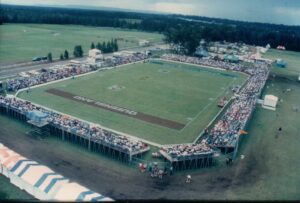State of Origin: 1995- The Birth of a New Era in Touch Football
December 2nd, 1995, will long be remembered as a milestone in the history of Touch Football. On that day, NSW played QLD in the very first-ever State of Origin series — a groundbreaking event designed specifically for television broadcast.
The series was played in Port Macquarie, coinciding with day two of the NSW State Cup. In a bold move, the State Cup was temporarily suspended from 12:00 to 3:00pm, allowing all participants the opportunity to witness the launch of a new era. NSW and QLD competed in four 30-minute games — two each for the Men’s and Women’s divisions — with footage from the series later turned into four televised games on both Channel 9 and Optus Vision.
To promote a faster, higher-scoring, and more spectator-friendly game, teams competed in a newly introduced six-a-side format, specially devised for the SOO Series, which opened up the field and encouraged attacking play. Negative defensive tactics were also addressed through the introduction of the “Mexican Stand-Off” rule, which forced defending teams to move off their line and engage, creating more space and excitement.
New, television-friendly uniforms were designed to give the broadcast a professional and modern look. Each game was reduced to two 15-minute halves, providing a punchier, high-intensity viewing experience.
The series wasn’t just about the game — it was a full-scale entertainment production.
A purpose built 4,000-seat grandstand wrapped around a freshly prepared stadium, with a state-of-the-art TV production crew on site. From the Mexican wave, to dancing girls, smoke flares, fireworks, music, balloons, and even a helicopter landing, every element was designed to grab attention and leave a lasting impression.
Touch Football in 1995 was thriving at the grassroots level but struggling to cut through in the media space. At the elite representative level, the game had become bogged down by technical, low-risk tactics — repetitive dumps, conservative play — that didn’t translate well to a viewing audience. Something had to change.
That change came with the support of Liptonice, who came on board as a commercial sponsor, giving the event both the financial backing and national visibility it needed. With broadcast exposure finally within reach, Touch Football was forced to make a bold leap: it had to evolve from a participant sport into a true spectator product.
The shift to six-a-side proved to be the most effective antidote — speeding up the game, increasing scoring, and showcasing the full flair of the athletes.
Another key and controversial move came with the decision for female players to wear body suits on camera. It was a choice led by television producers who believed the women’s game needed something that would catch the attention of the casual viewer, particularly in a pub or lounge room setting. Yes, by today’s standards the decision feels sexist, and even at the time it was met with cynicism — but it reflected the era’s marketing mindset. The hope was that once people looked up, they’d keep watching — and they did.
Behind the scenes, the administration was juggling the fast-moving pieces of a sport undergoing reinvention. The Origin series fast-tracked several rule changes already under review. The focus shifted toward encouraging more ball movement, more attacking opportunities, and ultimately, a more entertaining product.
The 1995 State of Origin series wasn’t just the rebirth of a rivalry, it was a bold declaration that Touch Football was ready for prime time.
It laid the groundwork for what the sport could become: fast, exciting, televised, and proudly promoted by the Blues and Maroons. And perhaps most importantly, it proved that Touch Football could be just as thrilling to watch as it is to play.

